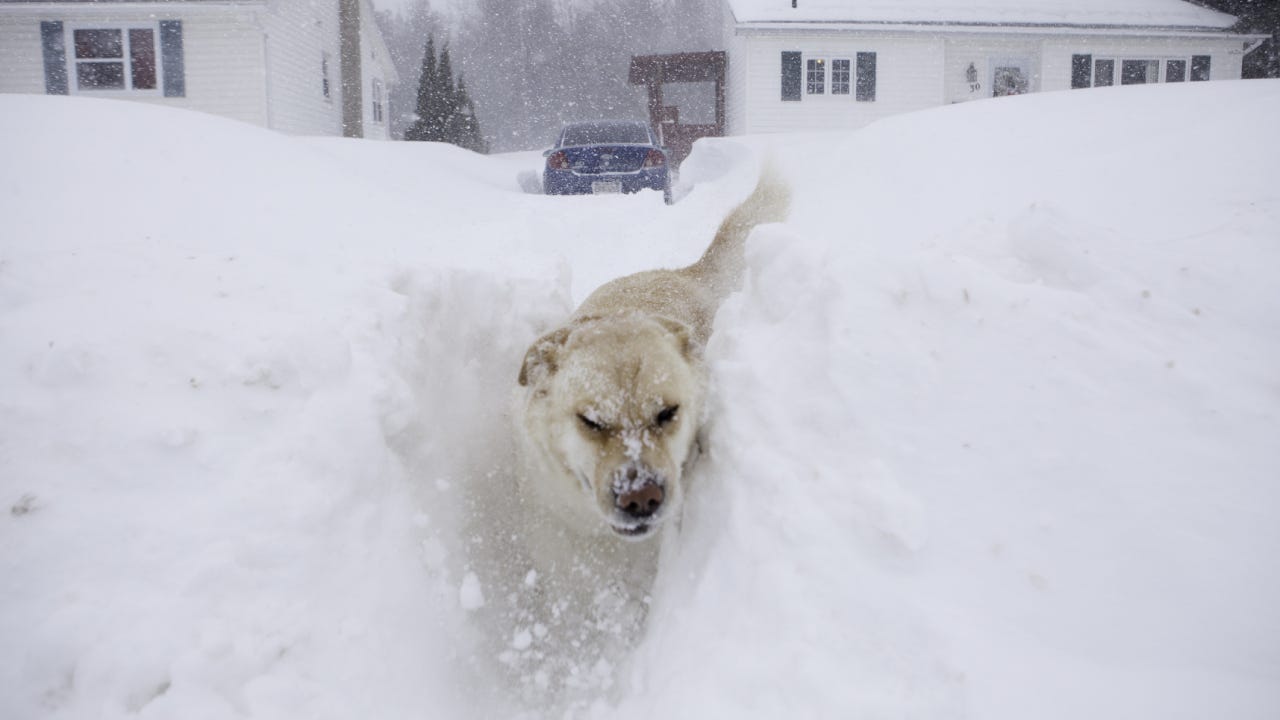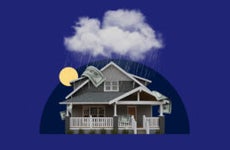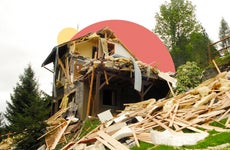The most expensive winter storms

The Bankrate promise
At Bankrate, we strive to help you make smarter financial decisions. To help readers understand how insurance affects their finances, we have licensed insurance professionals on staff who have spent a combined 47 years in the auto, home and life insurance industries. While we adhere to strict , this post may contain references to products from our partners. Here's an explanation of . Our content is backed by Coverage.com, LLC, a licensed entity (NPN: 19966249). For more information, please see our .
Our writers and editors used an in-house natural language generation platform to assist with portions of this article, allowing them to focus on adding information that is uniquely helpful. The article was reviewed, fact-checked and edited by our editorial staff prior to publication.
Winter weather brings thoughts of cozy fires, frosty wonderlands and snowball fights, but in reality it can also be incredibly destructive. From blizzards to ice storms, winter storms can cause billions of dollars in damage to homes and properties and a death toll that competes with other types of extreme weather. Bankrate explores the most expensive winter storms in U.S. history to help you understand the potential damage these storms can cause and how to prepare to mitigate your risks.
The damage caused to homes by winter storms
Winter storms can create a blizzard of problems for residential properties, from minor inconveniences to severe structural damages.The four main types of winter storms, including blizzards, ice storms, lake-effect storms and snow squalls, are characterized by snow, wind and cold. Here’s a breakdown of the main types of damage that winter weather can cause to homes:
- Frozen and Burst Pipes: The plunging temperatures of winter can cause the water inside your pipes to freeze. When this happens, the pipes can burst, leading to water leaks and potential mold problems.
- Drain Backups: The freezing and thawing cycles common in winter can lead to blocked drains, which can create significant issues, including unsanitary living conditions.
- Ice Damming: Ice accumulations on your roof can prevent melting snow from draining properly. This can lead to water seeping under your roof shingles, causing leaks inside your home.
- Gutter Damage: Heavy snowfall can weigh down your gutters, causing them to bend, break or detach from your home. This can result in potential water damage to your property.
- Power Outages: Freezing rain can snap power lines, disrupting your home’s heating systems. This raises the risk of fire and carbon monoxide poisoning if alternative heating methods are used improperly.
- Wind/hail Damage: Winter storms can also bring hail and high winds, which can cause significant damage to your home’s exterior, including the roof, siding and windows. From fallen tree branches to flying objects, your home and vehicle can suffer extensive damage.
Given these potential issues, it’s crucial for homeowners to prepare for winter weather by inspecting and maintaining their homes. This includes ensuring that your property is properly insulated, gutters are cleaned out and that a contingency plan is in place for potential power outages.
The worst winter storms in U.S. history
Winter storms have the potential to inflict significant damage on property and infrastructure, resulting in large insurance claims. According to the latest data compiled by the Insurance Information Institute (Triple I), winter storms caused almost $6 billion in damage in 2022. Only one winter storm in 2023 passed the billion-dollar mark and while the snow and extreme winds experienced across the Northeast didn’t make the list of the 10 most damaging winter storms on record, it did break a different record. New Hampshire recorded wind chills as low as -108 degrees Fahrenheit.
The most expensive winter storms in U.S. history, adjusted for inflation to 2023 dollars, are as follows:
Polar vortex
The Great Texas Freeze in February 2021 introduced the term polar vortex and caused every county in Texas to be placed under a Winter Storm Warning. The freezing temperatures lasted over eight days, forcing over 10 million Texas residents to go without electricity and causing pipes to burst and a chain of other damaging events from car accidents to bare shelves at grocery stores. The end result was winter storm damage impacting 26 states and costing more than $17.4 billion.
December storm of 2022
The winter storm of December 2022 covered the Central and Eastern regions of the U.S., but may have hit Buffalo, New York the hardest. Hurricane winds and snow squalls caused massive structural damage to buildings and infrastructure and caused the death of 47 residents. Across the country, more than a million customers were without power and losses totaled more than $7.9 billion.
The Storm of the Century
In mid-March 1993, the “Storm of the Century” swept across the U.S., impacting nearly half the nation’s population. With wind speeds equivalent to a Category 3 hurricane, the storm caused an estimated $4.4 billion in damages in today’s money. The storm was notable not only for its size and cost but also for its intensity, resulting in tornadoes, heavy snowfall, extreme cold and coastal flooding. Despite the severity of the storm, the National Weather Service’s accurate forecasting and the public’s heed to warnings played a critical role in lessening the storm’s impact.
February storm of 2015
The winter storm of February 2015 had a significant impact on the Northeast, particularly Boston, which recorded its highest ever monthly snowfall. The storm wreaked havoc on transportation systems, leading to road closures and flight cancellations. The South was also affected, with regions like Alabama, Mississippi and Georgia experiencing their most substantial snowfall in more than 10 years.
December 1983 storm and cold wave
The December 1983 storm and cold wave resulted in the chilliest Christmas on record in Northeast Ohio and Northwest Pennsylvania. The storm resulted in snow drifts towering between 10 to 15 feet due to 6 to 20 inches of fresh snow. The freezing temperatures lasted for several days, affecting the entire continental United States, except for the southwestern deserts.
January storms of 2014
The January 2014 storms resulted in risky travel conditions, school closures and a wave of cancellations due to snowy conditions, blizzards and harsh wind chills. The storms started on the night of Jan. 25, with a gentle snowfall of 1 to 4 inches across the Upper Midwest, leading to widespread disruptions across the affected areas.
December winter storm of 1992
The December 1992 storm, known as the “Great Nor’Easter,” swept through numerous states, bringing with it snow, sleet, rain and powerful winds. Coastal areas experienced tidal surges that were 1 to 4 feet above the norm and waves that reached heights of 20-25 feet near the coastline. Major flooding was widespread, with Boston and New York City submerged under 4 to 5 feet of floodwater.
The Great Appalachian Storm of 1950
Thanksgiving weekend in 1950 is when residents in the Eastern U.S. experienced a cyclone-type storm that caused blizzard-like conditions with massive snowfall, piling up to 62 inches in areas in West Virginia. The Regional Snowfall Index ranked this storm as Category 5 — the most dangerous. Not only did this storm spread wind, snow and cold temperatures from the Northeast to the Southeast, but many parts of the country saw immense flooding due to higher-than-normal temperatures that immediately followed the winter storm.
March storm of 2018
The March 2018 nor’easter brought heavy snow and chilly weather to Central New York, Northeast Pennsylvania and other areas of the Eastern U.S. The storm produced a heavy snowfall, with places in New York getting more than 20 inches of snow. This meteorological event was just one of several significant weather phenomena in the early part of 2018, including other Nor’easters that affected the region.
The Nashville Ice Storm of 1951
The “Great Blizzard” of 1951 covered nearly 1,000 miles across from Louisiana to West Virginia. This unique storm caused snow and rain to freeze, then thaw and refreeze, which resulted in a solid sheet of ice across numerous states and lasted 10 days. About 100,000 customers were without power and homes using cutting-edge technology at the time, like electric stoves and telephones, were rendered useless. It was estimated that this storm caused over $150 million in damage, which is about $1.8 billion when adjusted for inflation (2023 dollars).
What your insurance covers during winter storms
Most standard homeowners insurance policies provide coverage for winter storm damages. Below are common insurance coverage types that offer financial protection against most winter storm damage:
- Dwelling coverage: This is the most essential element of a home insurance policy and covers the structure of your home. If a falling tree damages your home during an ice storm, you sustain water damage from a broken pipe, or if your roof is damaged by winter hail or severe winds, this is the coverage that would protect you.
- Other structures coverage: This coverage type works similarly to dwelling coverage, but it covers detached structures like sheds, gazebos, fences and detached garages.
- Personal property coverage: If your belongings — including your furniture, clothing, jewelry or home decor — are damaged during a winter storm, this coverage is essential. You can choose either actual cash value (depreciation is factored into your claim) or replacement cost coverage (provides full value replacement).
- Additional living expenses: If you aren’t able to live in your home due to a covered loss, this coverage could pay for your temporary living at a hotel or rental fees, restaurant meals and even pet boarding.
Keep in mind that most policies have exclusions that limit or deny specific types of damage caused by weather, such as flood damage resulting from winter-related floods. Also, if the home hasn’t been properly prepared for winter or is left vacant for a long time, certain exclusions may apply.
Triple-I recommends all U.S. homeowners consider adding flood insurance regardless of where you live. Flood insurance can be purchased through the National Flood Insurance Program or dozens of flood insurers.
When filing a claim, you will be responsible for paying your home insurance deductible, which is usually a flat amount ranging from $500 to $2,000. However, some policies have percentage-based deductibles for wind and hail damage. To mitigate loss, most policies have a condition that requires homeowners to take preventative measures and make temporary repairs while waiting for the insurance adjuster, such as boarding up windows and tarping a damaged roof. The cost of these repairs is typically reimbursed by the insurer. Being familiar with the deductible and policy terms and conditions can help you be more prepared when facing winter storm damage. It may be a good idea to keep all receipts for any repairs you need to pay for out of pocket.
Strategies to enhance disaster resilience during winter storms
Several strategies can enhance disaster resilience during winter storms. These preventative steps can range from how your home is designed to simply keeping up with your lawn maintenance. Here are a few for you to consider:
- Protect pipes from freezing: Water pipes should be located within the insulated parts of buildings to prevent freezing. Consider investing in pipe insulation or heat tape and don’t let your thermostat drop below 60 degrees.
- Invest in a backup standby or portable generator: If someone lives in your home relies on medical equipment, having a backup standby generator to kick in during a power outage can save their lives. For heaters and small appliances, a portable generator can be a more cost-effective option. (If you do keep a generator inside your home, it’s important to follow property safety protocols such as proper ventilation.)
- Maintain your home’s exterior: Keeping gutters and downspouts free of debris may help prevent or minimize flooding that can happen after a heavy snowfall. The weight of ice and snow can cause trees to damage your roof and other structures. Trimming back tree branches before winter starts can reduce the risk of damage.
- Have an annual winter inspection: Having chimneys, roofs and HVAC systems inspected annually can make you aware of a small issue before it becomes a bigger one. Not only does this lessen the chance of a claim, it can help you avoid carbon monoxide poisoning, which tends to increase in winter when heaters are run more frequently.
On a larger scale, communities must stay informed of the dangers of hypothermia and carbon monoxide poisoning and where to go for shelter in an emergency. With extreme weather becoming more frequent and intense, municipalities focusing on strengthening and restructuring their power grids for a future beyond fossil fuels will help put their citizens in a more stabilized environment.
Frequently asked questions
-
-
The best home insurance company to protect against storm damage depends on a variety of factors, including the level of coverage you need, your budget, and the company’s reputation for customer service. Some top-tier choices for homeowners concerned about storm damage include Liberty Mutual, Allstate and Farmers. Liberty Mutual stands out for its comprehensive coverages for winter hazards, while Allstate shines with its broad coverage options, and Farmers is praised for its customizable policies.
-
Several types of insurance policies offer protection against the destructive effects of winter storms. Most standard homeowners insurance policies cover damage from winter-related incidents such as wind, snow, ice, freezing rain and extreme cold. However, they usually do not cover flood damage from winter-related floods, necessitating separate flood insurance. Comprehensive and collision auto insurance can cover damage to your car due to winter conditions, while renters insurance covers damage to personal belongings due to winter weather. It’s always wise to review your insurance policies before winter to ensure you have the appropriate coverage.
-
Severe winter storms most often strike the upper Midwest and the Great Plains in the United States. These regions lack natural barriers like trees that could lessen the effects of wind and blowing snow, making them particularly susceptible to blizzards. However, it’s important to note that blizzards can occur anywhere that experiences snowfall.
-
Whether your auto insurance covers winter storm damage to your car depends on the type of coverage you have. Comprehensive coverage, for example, may cover weather-related damage, such as damage from falling trees or heavy ice. Collision coverage may cover damage resulting from a covered accident, such as your car skidding on black ice and hitting a fence. However, auto insurance does not cover regular wear and tear caused by winter weather. Consider having your car inspected before winter to prevent potential problems and reviewing your auto insurance policy to ensure you have enough coverage for potential winter-related events.
-
To protect your home from winter weather risks, you may want to take preventive measures both inside and outside your home. For the exterior, consider cleaning your gutters, installing gutter protectors, pruning your trees and repairing any stairs and railings. Inside your home, you may want to increase your insulation in the attic, basement and crawl spaces to minimize heat loss and prevent ice dams on your roof. Make sure your heating system has been serviced and consider a reliable alternative power source to keep your home warm and prevent pipes from freezing during a power outage. You may also want to enhance pipe protection with insulation or heating cables, introduce an emergency pressure release valve in your plumbing system and be careful with the placement of flammable items near heat sources. Lastly, make sure you have smoke and carbon monoxide detectors installed and functioning properly.
-
Related Articles

What is inflation? Here’s how rising prices can erode your purchasing power

April showers bring more than May flowers: Does homeowners insurance cover rain damage?

Every American is losing money due to extreme weather. Here’s how.

Extreme weather’s financial impact on drivers and homeowners